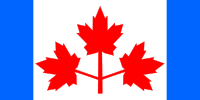 In the 1940s, however, the Red Ensign became the national flag. Still, there were several national political movements over the years that were built specifically around the idea of creating a unique Canadian flag. In 1958, an extensive poll was taken of the attitudes that Canadians held toward the flag. Over 80% of people polled wanted a national flag entirely different from that of any other nation, and 60% wanted their flag to bear the maple leaf.
In the 1940s, however, the Red Ensign became the national flag. Still, there were several national political movements over the years that were built specifically around the idea of creating a unique Canadian flag. In 1958, an extensive poll was taken of the attitudes that Canadians held toward the flag. Over 80% of people polled wanted a national flag entirely different from that of any other nation, and 60% wanted their flag to bear the maple leaf. Finally, after much ballyhooing and whatnot, a committee was formed to come up with a new Canadian flag. During the next six weeks the committee held 35 tormenting meetings. Thousands of suggestions also poured in from the public.
3,541 entries were submitted, many containing common elements:
• 2,136 contained maple leaves
• 408 contained Union Jacks
• 389 contained beavers
• 359 contained Fleurs-de-lys
At the last minute, a flag designed by historian George Stanley was slipped into the mix. The design put forward had a single red maple leaf on a white plain background, flanked by two red borders, based on the design of the flag of the Royal Military College. The voting was held on October 22, 1964, when the committee’s final contest pitted the Pearson’s Pennant (see below) against Stanley’s design. Assuming that the Liberals would vote for the Prime Minister’s design (Pearson’s), the Conservatives backed Stanley.
 They were out-maneuvered by the Liberals who had agreed with others to choose the Stanley Maple Leaf flag. The Liberals voted for the red and white flag, making the selection unanimous (14–0).
They were out-maneuvered by the Liberals who had agreed with others to choose the Stanley Maple Leaf flag. The Liberals voted for the red and white flag, making the selection unanimous (14–0). Since the adoption of the flag, some have pointed out that by the process of figure-ground reversal, the flag design can be seen as a profile picture of two angry men, who have been nicknamed Jack and Jacques in an allusion to Canada's linguistic and cultural duality.
Since the adoption of the flag, some have pointed out that by the process of figure-ground reversal, the flag design can be seen as a profile picture of two angry men, who have been nicknamed Jack and Jacques in an allusion to Canada's linguistic and cultural duality.
3 comments:
The two angry men appear to be head-butting. Do they do a lot of that in Canada? I mean, I know they live among moose, elk, caribou, and whatnot, but seriously...is it practical?
Fascinating history, though. I wish the political turmoil in our country could be about something as benign (though still important) as a flag design. If we ever have to get a new flag design, which I strongly oppose, I vote for a profile design of two angry women catfighting. Better yet, I think the design should be one of those 3-D images you have to stare at for a long time until the picture comes into focus. That would cause a lot of brain damage on windy days.
Those are great ideas, Troy. I was thinking of updating our flag to some sort of 80s psychadelic design, but your 3D idea is unbeatable. I will begin the lobbying process. :)
I think it's funny that you consider the 80's a psychedelic era. =)
Post a Comment